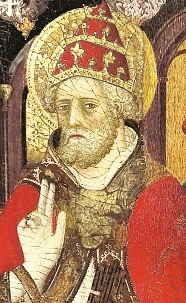The Popes of Provence: ‘Only in Provence’ Part 7
One of the highlights of a visit to Avignon is seeing the magnificent Papal Palace, once home to seven popes. But what were they were doing in Avignon rather than Rome? Why did the papacy relocate from the Vatican to Provence? It’s an interesting tale.

For centuries, popes jockeyed with kings and emperors for worldly power. Things came to a head in the early 14th century when Pope Boniface VIII decided to excommunicate King Philip IV of France (this was not a good idea.) This enraged the king, and before long forces loyal to him attacked and beat the pope, who died soon after. His successor was short-lived and King Philip forced the next papal conclave to elect his personal friend, Bertrand de Got, as Pope Clement V.
Pope Clement refused to go to Rome and set up shop in Avignon instead—the city and surrounding territories were then part of the Papal States. Thus began the Avignon Papacy, or as some in Rome snidely call it today, the Babylonian Captivity.
From 1309 to 1376, a series of seven popes held court in Avignon, and, not surprisingly, all were French. It was these popes who built the enormous Papal Palace and the massive walls around the city. Further north, they built a château in a town now called Châteauneuf-du-Pape (“the pope’s new château.”) Then they covered the surrounding countryside with vineyards because, well, popes need to drink. Today Châteauneuf-du-Pape produces some of France’s greatest wines.

Things began to fall apart in 1376 when Pope Gregory IX decided to move back to Rome. After he died, competing groups of cardinals elected two different popes, one in Rome and one in Avignon. This “Western Schism,”, with its competing popes, continued until 1417 when Church leadership was finally unified. The popes elected in Avignon after 1376 are now considered antipopes and, not surprisingly, no troublemaking Frenchman has been elected to the Papacy since. For those who wish to explore the legacy of the Avignon Papacy, here are some places to visit.
The Palais des Papes

Both a fortress and a palace, the Papal Palace is one of the largest and most important medieval Gothic buildings in Europe. It is actually two buildings joined together—an older fortress/palace built on the impregnable Rock of Doms, and a newer and more lavish palace built by one of the Avignon popes. Information about visiting can be found here.
The Ramparts
These massive walls are one of the finest examples of medieval fortifications in existence. They can be seen throughout the city but some of the most dramatic are along the side facing the Rhône River.

The Pont d’Avignon
Many of us know the children’s song about this famous bridge (“Sur le Pont d’Avignon, l’on y danse, l’on y danse.”) Formally known as the Pont Saint-Bénézet, it was completed shortly before the Avignon Papacy. It connected the city to the town of Villeneuve-lès-Avignon on the other side of the Rhône, where the cardinals built their palaces.
Sadly, only a small part of the original bridge still remains, but a team of French historians recently recreated it in 3D, as you can see in this fascinating video.

Châteauneuf-du-Pape
The remains of the old papal château still dominate the town, and the view from it is outstanding, with lush vineyards in all directions. Be sure to visit a few wineries to taste some of the best wines in France.
The Pope’s Jews
During a time when Jews were expelled from most of France, the Popes offered them protection in the Papal States, where they were known as les Juifs du Pape (the Pope’s Jews.) You can still see ancient synagogues and mikvehs throughout the area, including the oldest synagogue in France.
How aware were you of this history? Please share your thoughts and experiences in the comments section below.
Image credits:
- Palais des Papes: Creative Commons License, attribution Jean-Marc Rosier
- Pope Innocent VI: from a work which is in the public domain
- Antipope Benedictus XIII: from a work that is in the public domain
- Pont d’Avignon: Creative Commons License, attribution Henk Monster
- Chateauneuf-du-Pape: Creative Commons License, attribution Aa77zz
Only in Provence
There is much to celebrate and experience in Provence.
This series sets out to create a collection of highlights – unique features and experiences to be had in Provence.
Use this series to create your very own must-do list.
Only in Provence Part 1 – Brilliant Roussillon
Only in Provence Part 2 – Carrières de Lumières
Only in Provence Part 3 – Provence legends
Only in Provence Part 4 – Surprising history of Jewish Provence
Only in Provence Part 5 – The Animal Kingdom of Provence
Only in Provence Part 6 – Roman Provence
Only in Provence Part 7 – The Popes of Provence (this one)






